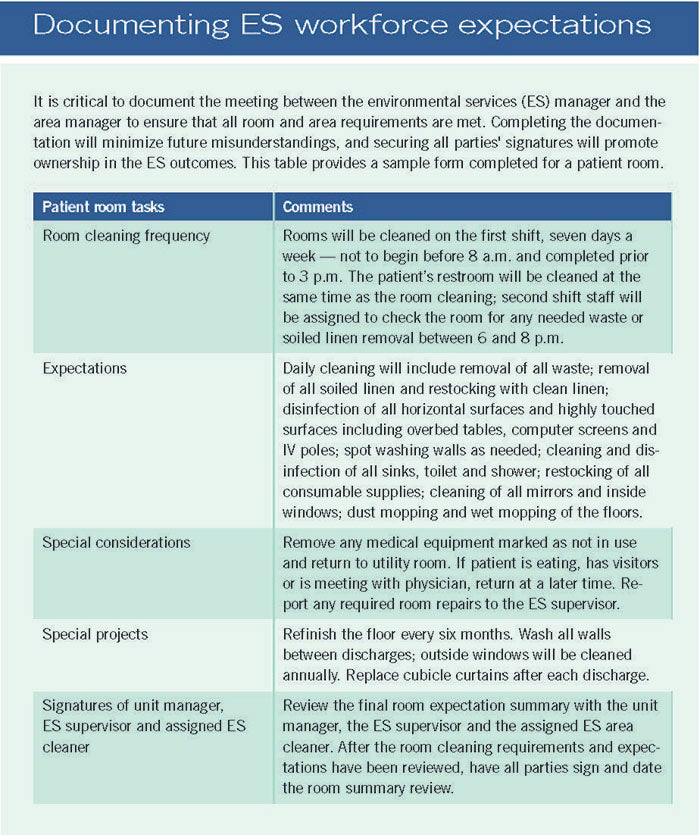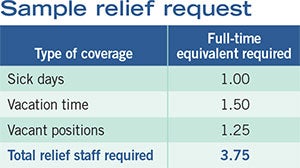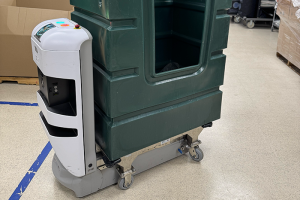Eight environmental services workforce planning steps
Environmental services (ES) professionals recognize that labor expenses are a key component of all ES budgets. Labor costs typically comprise at least 90 percent of all ES expenses. Therefore, it is imperative that ES workforce budgets accurately reflect the labor required to accomplish the team's main goal — to provide a clean and safe environment.
Eight key steps
To accomplish this goal, there are eight key steps to take. By following and completing these steps, an ES professional can be assured that labor expenses accurately reflect what is needed to provide the facility with excellent results:
1. Meet with the users or owners of the room or area of care. It is important to fully understand the needs and expectations of end users. ES professionals should meet with each unit manager and review their expectations. Sample questions might include:
- How often should the room or area be cleaned? Most rooms require only daily cleaning, but there are exceptions.
- Is staffing required on one, two or three shifts? For example, operating room suites and emergency care units may require 24/7 staffing while office space usually only needs ES attention once a day, Monday through Friday.
- What time of day can the room be cleaned? Having more rooms cleaned on the day shift can save ES professionals expense in shift differential pay.
- What surfaces are expected to be cleaned by the ES staff? Is the ES employee expected to clean any of the medical equipment, computer screens, desktops or other special surfaces? ES professionals should be specific.
- What are the expectations for refinishing floors, carpet cleaning and other non-daily restoration work completed by the ES staff?
It is imperative that the needs of the area as well as the capabilities of the ES department are met. ES professionals should not be tempted to promise more than can be delivered. Budgetary constraints invariably will come into play.
You may also like |
| 2016 ES Department of the Year awards |
| Trends in infection prevention |
| 2015 ES Department of the Year awards |
|
2. Review the room requirements. How large is the room? Room square footage can usually be collected through a hospital's facilities department. Using this available data will save ES professionals invaluable time. If this information is not available, they should measure the cleanable square footage, noting whether the floor covering is hard surface or carpeted.
ES professionals should then record the number and types of fixtures the ES staff are expected to clean, assigning a cleaning time to each fixture. If they are unsure, they should refer to Steps 4 and 5.
ES professionals also should ask if there are any special considerations that require the attention of the ES staff. For example, if the patient unit comprises immunosuppressed patients, additional cleaning time will be required for daily isolation gowning and cleaning.
3. Review industry cleaning time standards. The ISSA's Cleaning Industry Management Standard provides a comprehensive listing of cleaning times for most surfaces, items and procedures ES professionals will encounter. This provides a good starting point for determining cleaning times as well as verifying cleaning times already developed.
Today, ES professionals also have access to a number of software programs that can be used to determine room cleaning times.
4. Complete time studies. ES professionals should select staff members to complete time studies. Staff member selections should be based on whether they have demonstrated excellence in their performance. Final cleaning times should reflect the importance of adherence to high cleaning standards and high patient, visitor and staff satisfaction.
ES professionals should review the room cleaning expectations as determined from completing Steps 1 and 2 with the selected staff members.
A room should be cleaned by the selected ES staff members at least two times. However, there is no need to complete a time study for every room. For example, if there are 450 similar patient rooms in the facility, there is only a need to complete the time study in one patient room.
Similarly, ES professionals can extrapolate cleaning times for spaces that share common traits or usage. For example, complete time studies on a typical office space of 100 square feet. If the 100-square-foot office space requires five minutes to clean (or 20 feet per minute), it can be assumed that a similar space measuring 160 square feet will require eight minutes to clean.
The same process can be used for all types of rooms that require cleaning by the ES staff. ES professionals should determine cleaning time standards per 1,000 square feet cleaned for every type of room under the responsibility of the department. ES professionals should keep it simple: For each room, they should round up or down to the nearest full minute.
Finally, ES professionals should complete a formal room-cleaning inspection after each time-study cleaning. Ensure that the cleaning is complete and meets ES and facility cleaning standards. The goal is to have time studies that accurately reflect cleaning time requirements as well as high cleaning standards.
5. Identify work that is based on volume. Not all cleaning duties performed by the ES staff are based on square footage. Some are based on volume. When completing the time studies outlined in Step 4, ES professionals also should complete the time requirements for any volume-based assignments.
A common cleaning task based on volume is the number of discharged patient rooms that are expected to be cleaned each day. Annual discharge data typically can be obtained through a hospital’s bed management program or the finance department. This information can be used to determine the facility’s daily discharge activity.
It is important for ES professionals to gather this data for each day of the week because discharge patterns will vary from day to day. Higher discharges usually occur later in the week while weekend days usually have a lower number of discharges. Gathering and incorporating this information in the final workforce plan will ensure that daily staffing is correct.
Other volume-based tasks might include emergency department (ED) visits and the number of surgical cases performed each day, if the ES staff are responsible for cleaning the surgical suites between cases.
ES professionals should determine the hours required to complete project work including, but not limited to, refinishing hard floor surfaces, carpet and upholstery cleaning and window washing. Frequency of project work should be discussed when meeting the users and managers of the areas cleaned, as described in Step 1.
Some ES departments also are responsible for nontraditional tasks such as snow removal, landscaping and meeting setups. ES professionals also need to determine frequencies and time requirements for these tasks as part of the overall staffing model.
Finally, some areas require an ES presence that is not based on cleaning time or volume. A common example is the ED. This unit usually requires an ES presence 24/7 to ensure that clean rooms are always available for emergency patient arrivals.
Determining if one or more ES staff members are required will be dictated by the size of the ED and the number of emergency cases the unit typically intakes each day. ED visit data, by shift and day of the week, may be obtained from the hospital’s finance department. ES professionals should use this data in conjunction with communication with the ED staff to determine the required staffing. This process also can be used when determining the ES staffing required in the surgery department.
6. Compile the data collected to determine total staff requirements. ES professionals should determine the productivity standard for each type of space cleaned, compiling a summary list that denotes how much space can be cleaned per hour for each type of room and space. For example, if the total patient room square footage is 300,000 and the productivity standard for patient rooms is 1,200 square feet per hour, the work hours needed for patient room cleaning is 300,000 divided by 1,200, which equals 250 work hours per day. To calculate the weekly hours, it should be multiplied by seven for a total of 1,750 hours.
ES professionals must remember to take into account the hospital’s average daily census. If it is 80 percent, 1,750 should be multiplied by 80 percent. In this example, 1,400 hours are required to complete daily cleaning of the patient rooms.
ES professionals should complete the same process for cleaning all types of rooms and space that is based on square footage.
A similar process should also be completed for volume-based cleaning. For example, patient discharge room cleaning staffing requirements are based on the number of patient discharge rooms that must be cleaned each day. To determine the required ES staffing to complete daily discharges, ES professionals should obtain the hospital’s discharge data for the previous year. Assuming that no significant changes in patient activity occurred, this number will provide a good benchmark.
An annual discharge total of 10,950 denotes a daily discharge average of 30 (10,950 divided by 365 days equals 30). If a daily discharge requires 45 minutes to clean, the weekly hours that should be budgeted for discharge cleaning will be 30 discharges per day multiplied by 7 days per week (210) multiplied by 45 minutes (9,450) and divided by 60 minutes, or 157.5 hours.
A chart similar to the "Sample budget summary for required ES staffing" (above) will provide an accurate budget summary of the staffing required for the ES department. This is only a sampling of rooms, areas and tasks that might be included in a staffing summary. The total is derived by adding the “Weekly staffing” column and then dividing by 40 hours, or one full-time equivalent (FTE) staff member.
7. Determine ES relief staff required to cover for sick days, vacation days and open positions. ES staff earn paid time off to cover for sick leave days and vacation time. Staff will still be required to cover for this time. Sick-day usage usually can be obtained through a hospital’s payroll department. For instance, if the annual average sick-day usage for the ES department is 6,240 hours, three FTEs should be budgeted for sick-leave coverage. This is because one FTE equals 2,080 hours and 2,080 divided into 6,240 is three.
Typically, most ES staff also will earn vacation time. The amount of time off may vary based on years of service. The most accurate method to determine vacation coverage is to total the amount of vacation days each employee earns. For example, if the total vacation earned by the ES staff totals 390 days, then 1.5 FTEs will need to be budgeted for vacation coverage. This is derived by multiplying 390 by eight hours, then dividing the results (3,120) by 2,080.
Finally, ES professionals should work with the hospital’s human resources department to calculate the number of ES FTEs needed to cover vacant positions. It is rare for an ES department to have all positions filled at all times. If the ES department averages 1.25 vacant positions each day, then 1.25 FTEs should be budgeted. The required relief staff is then added to the ES department’s total staffing requirements, as illustrated in the chart "Sample relief request" (above).
8. Complete the final staffing model. Add the totals from the charts completed in Steps 6 and 7. This final table will encompass all of the staffing needs for the ES department and provide an excellent basis for verifying the ES labor budget and making future changes.
Thomas A. Peck is an environmental services consultant based in Madison, Wis.






